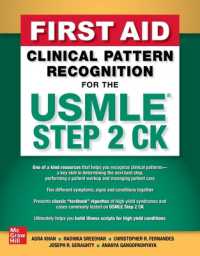Full Description
Taking a future-oriented approach, this book addresses students' ways of thinking in STEM-based problem solving. It provides a rich set of chapters that explore how we can advance important thinking skills in STEM education for K-12 students.
STEM education is essential to understanding and solving many of the world's major challenges. However, the kind of interdisciplinary modes of thinking required to tackle such unforeseen problems is lacking in most STEM education delivery. This book examines the various ways of thinking that can be applied to effective STEM-based problem solving across K-12 education. These include design and design-based thinking, systems thinking and modeling, critical thinking, innovative and adaptive thinking, intuition in problem solving, and computational and algorithmic thinking. Across the chapters, the authors' interdisciplinary perspectives give further depth to understanding how students learn and apply their thinking to solve STEM-based problems. The book also provides guidance on how to assess ways of thinking in STEM education, to ensure educators can recognize students' progress and development.
Bringing together a team of international experts, this book is essential reading for pre-service teachers, teacher educators, and researchers in STEM education.
Chapter 2 of this book is freely available as a downloadable Open Access PDF at http://www.taylorfrancis.com under a Creative Commons Attribution-Non Commercial-No Derivatives (CC-BY-NC-ND) 4.0 license.
Contents
1. STEM-based Problem Solving in a New Era 2. STEM in a changing world: 'insider' and 'outsider' perspectives 3. Global creative disruption and implications for STEM-based problem solving and learning 4. STEM ways of thinking: Elementary grade learners' possibility and adaptive thinking in STEM-rich contexts 5. The critical role of intuition in problem solving 6. Nexus for STEM Problem Solving and Transfer Research: Instruction First or Productive Failure First? 7. Students' Systems Modeling: A Classroom of the Future 8. Systems thinking in the early grades 9. Systems Thinking Journeys of Preschool Teachers: A Leverage Point for Problem Solving 10. Perspectives on Design Thinking within STEM 11. Design-based thinking in problem solving in technology and across the STEM disciplines 12. Engineering Design in STEM-based Problem Solving 13. Engineering design reasoning for conscientious decision-making 14. Critical thinking in STEM education 15. Critical Thinking in Mathematics and Mathematical Modelling Related to STEM 16. Computer programming puzzles, mathematics education, and the culture of learning 17. Computational Problem Solving in STEM education 18. Challenges in assessing students' STEM-based problem solving 19. Ways of thinking and STEM-based problem solving: Toward the future







